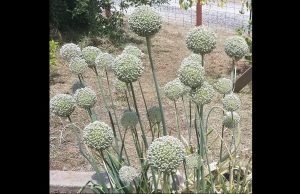Sponsored by:
Allium is the name given to a genus of plants that includes onions, garlic, scallions, shallots, leeks and chives. Allium is the Latin word for garlic. Alliums grow wild throughout the world and were once considered part of the lily family, but are now classified in the Amaryllidaceae family.
Cultivated alliums are known worldwide and used in kitchens as spices, vegetables and for medicinal purposes. They are an important part of daily diets, used alone or to flavor many dishes. They can be seen under cultivation in many, if not most, home gardens.
Care needs to be taken with animals around alliums, as these plants are quite toxic to dogs and cats. Garlic is even more toxic than onions. Eating as little as .5% of a pet’s body weight can poison your pet.
Alliums in the flower garden are welcoming perennials. Large, softball-sized flowers on tall stems come in an exquisite variety of colors from blue to lavender to white and many hues in between. When they bloom and achieve their full height, their large flowers waving in the breeze are breathtaking. Cut allium flowers make excellent bouquets, either fresh or dried. These plants are relatively resistant to deer, voles, chipmunks and rabbits. Even in a crowded garden, the choice to add alliums will create height and dazzling color, while not taking much space.
Alliums are grown from both bulbs and root clumps. Bulbs should be planted in well-draining soil at a depth of three times the bulb’s diameter. They prefer full sun but will tolerate some shade. Plant your bulbs in neat rows of 10 bulbs a few inches apart. When they grow you will get one stem per bulb with one flower per stem. Plants bloom in early summer in planting zones 3-8. After they bloom, it’s important to leave the foliage intact on the plants; the bulbs need their foliage to produce energy for next year’s flowers. If you prefer a neater effect, you can easily pull off the leaves after they have dried on the plant.
Ornamental alliums are hardy, drought tolerant and can reseed untouched year after year. Being a tall plant, they are lovely planted with daffodils and tulips. Since they are naturally pest resistant, they can persist in your garden for years. They are very pollinator friendly, enjoyed by both bees and butterflies. Some favorite varieties of ornamental alliums are purple sensation, globe master, gladiator, Ozawa (a clumping type), corkscrew, and drumstick.
So, to recap, alliums are cultivated both for use in your kitchen garden and in the ornamental garden. Easy to grow, they have many colors and types from which to choose. They self-seed, are pest resistant and attract pollinators. They’ll add beautiful design and color to your garden. Enjoy looking at them and using them in your kitchen.
Diane Miller is a University of California Cooperative Extension Master Gardener of Tuolumne County.
UCCE Master Gardeners of Tuolumne and Calaveras Counties can answer home gardening questions. Call 209-533-5912 or fill out our easy-to-use problem questionnaire here. Check out our website here. You can also find us on Facebook.
"tasty" - Google News
January 16, 2022 at 10:43PM
https://ift.tt/3234D6u
Growing Beautiful And Tasty Alliums - MyMotherLode.com
"tasty" - Google News
https://ift.tt/2VXquX3
https://ift.tt/3c08sJp
Bagikan Berita Ini















0 Response to "Growing Beautiful And Tasty Alliums - MyMotherLode.com"
Post a Comment